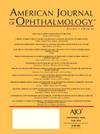Mental Health of US Children With Vision Impairment: An Analysis of the National Health Interview Survey
IF 4.1
1区 医学
Q1 OPHTHALMOLOGY
引用次数: 0
Abstract
Objective
While the psychological effects of vision loss in adults has been investigated, few studies focus on the adolescent population. Identifying the mental health burden of vision impairment in children may inform future detection and management of these symptoms. The purpose of this study is to characterize the association between mental health indicators and vision impairment in US children.
Design
Cross-sectional study.
Participants
Participants were children age 0 to 17 years from the 2022 National Health Interview Survey. Participants completed a household interview survey and Mental Health Assessment from the Strengths and Difficulties Questionnaire. Inclusion criteria is noninstitutionalized US civilians. Exclusion criteria is no fixed household address, active military duty, persons in correctional facilities or long-term care.
Methods
A population-based study using multistage complex probability sampling strategy to provide representative national estimates for children nationwide.
Main Outcome Measures
Caregiver-reported visual impairment and measures of psychological health including mental health (depression and anxiety), cognition (difficulties learning and remembering), behavior (social and emotional challenges), and access to services (mental health therapy and special education).
Results
In a sample of 6429 US children, 5% had visual impairments despite correction with glasses or contacts. Vision-impaired children had higher rates of depression (44%) and anxiety (64%) compared to nonvision-impaired children (33% and 53%, respectively). Adjusted models revealed that vision-impaired children had 1.2 times higher odds of depression (95% CI: 1.03-1.33) and 1.3 times higher odds of anxiety (95% CI: 1.13-1.46). They also had greater odds of learning difficulties (OR: 1.9; 95% CI: 1.29-2.86) and remembering difficulties (OR: 1.4; 95% CI: 0.99-1.82). Vision-impaired children showed higher total Strengths and Difficulties Questionnaire scores (OR = 1.1; 95% CI: 1.05-1.11), indicating more peer relationship issues, hyperactivity/inattention, and emotional symptoms. Additionally, there was a 30% to 50% decrease in the usage of mental health therapy and special education between youth with severe vs moderate depression and anxiety.
Conclusions
In this nationally representative 2022 sample, visually impaired children exhibit greater odds of depression, anxiety, cognitive impairments, and behavioral difficulties compared to nonvisually impaired children. Further understanding these relationships may improve the mental health outcomes of children at the population level.
美国视力障碍儿童的心理健康:对全国健康访谈调查的分析
目的:虽然已经对成人视力丧失的心理影响进行了调查,但很少有研究关注青少年人群。确定儿童视力损害的精神健康负担可能为今后发现和处理这些症状提供信息。本研究的目的是表征美国儿童心理健康指标与视力障碍之间的关系。设计:横断面研究参与者:参与者为来自2022年全国健康访谈调查(NHIS)的0-17岁儿童。参与者完成了家庭访谈调查和心理健康优势与困难问卷(SDQ)评估。纳入标准是非住院的美国平民。排除标准是没有固定的家庭住址、现役军人、在教养设施中的人员或长期护理人员。方法:以人口为基础,采用多阶段复概率抽样策略,对全国儿童进行具有代表性的全国估计。主要结果测量:照顾者报告的视力损害和心理健康测量,包括心理健康(抑郁和焦虑)、认知(学习和记忆困难)、行为(社会和情感挑战)以及获得服务(心理健康治疗和特殊教育)。结果:在6,429名美国儿童的样本中,5%的儿童尽管戴了眼镜或隐形眼镜,但仍有视力障碍。与非视力受损儿童(分别为33%和53%)相比,视力受损儿童的抑郁(44%)和焦虑(64%)发生率更高。调整后的模型显示,视力受损儿童患抑郁症的几率高出1.2倍(95% CI: 1.03-1.33),患焦虑症的几率高出1.3倍(95% CI: 1.13-1.46)。他们也有更大的学习困难的几率(OR: 1.9;95% CI: 1.29-2.86)和记忆困难(OR: 1.4;95% ci: 0.99-1.82)。视障儿童的SDQ总分较高(OR=1.1;95% CI: 1.05-1.11),表明更多的同伴关系问题、多动/注意力不集中和情绪症状。此外,患有严重抑郁和焦虑的青少年与中度抑郁和焦虑的青少年相比,使用心理健康治疗和特殊教育的人数减少了30-50%。结论:在这个具有全国代表性的2022年样本中,视障儿童比非视障儿童表现出更大的抑郁、焦虑、认知障碍和行为困难的可能性。进一步了解这些关系可能会在总体水平上改善儿童的心理健康结果。
本文章由计算机程序翻译,如有差异,请以英文原文为准。
求助全文
约1分钟内获得全文
求助全文
来源期刊
CiteScore
9.20
自引率
7.10%
发文量
406
审稿时长
36 days
期刊介绍:
The American Journal of Ophthalmology is a peer-reviewed, scientific publication that welcomes the submission of original, previously unpublished manuscripts directed to ophthalmologists and visual science specialists describing clinical investigations, clinical observations, and clinically relevant laboratory investigations. Published monthly since 1884, the full text of the American Journal of Ophthalmology and supplementary material are also presented online at www.AJO.com and on ScienceDirect.
The American Journal of Ophthalmology publishes Full-Length Articles, Perspectives, Editorials, Correspondences, Books Reports and Announcements. Brief Reports and Case Reports are no longer published. We recommend submitting Brief Reports and Case Reports to our companion publication, the American Journal of Ophthalmology Case Reports.
Manuscripts are accepted with the understanding that they have not been and will not be published elsewhere substantially in any format, and that there are no ethical problems with the content or data collection. Authors may be requested to produce the data upon which the manuscript is based and to answer expeditiously any questions about the manuscript or its authors.

 求助内容:
求助内容: 应助结果提醒方式:
应助结果提醒方式:


